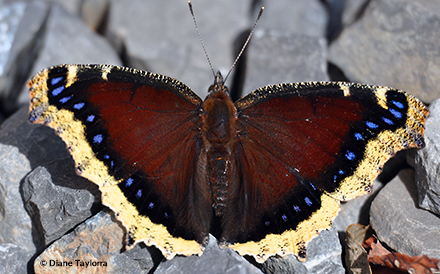
SCIENTIFIC NAME
Nymphalis antiopa
DESCRIPTION
Adults - The upper wings of the Mourning Cloak Butterfly are red-brown with a thick yellow border along the edge. On the inside edge of this border are bright blue elongated spots. The underside of their wings are dark with thin irregular lines. The border is duller than the upper side and the blue spots are more V shaped. Their wingspan can range from approximately five to ten centimeters. The more north they are found the smaller they tend to be. Caterpillars – The caterpillar is black with tiny white dots and black-branched spines. It has a row of red marks on its back between the bases of these spines.
RANGE
Mourning Cloaks are found across Canada and as far north as the tundra. They are one of the few species of butterfly whose range extends into Europe and Asia.
HABITAT
Mourning Cloaks can be found in a number of habitats including shorelines, forests and woodlands, fields, gardens and parks.
DIET
Adults – While Mourning Cloak butterflies do forage on flowers for nectar, they generally prefer tree sap, such as maple, poplar, oak and birch. They are a species of butterfly that ‘mudpuddles’, which means they get minerals from damp sand, manure, compost as well as rotting fruit and other moist organic matter. Caterpillars - Mourning Cloak larvae feed on a variety of trees such as elms, many willows, hackberries, Paper Birch and trees in the Populus genus such as Trembling Aspen and cottonwoods.
